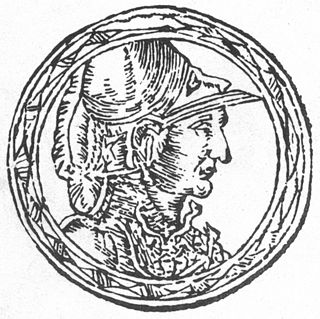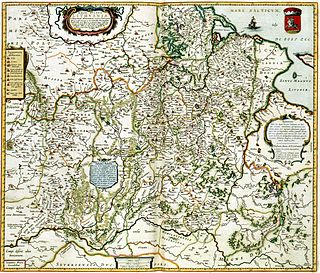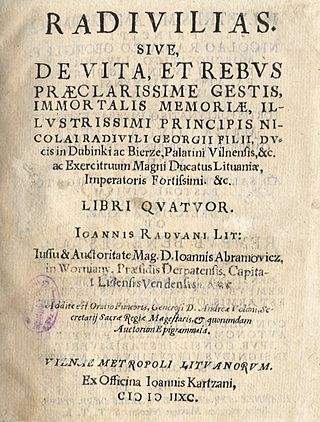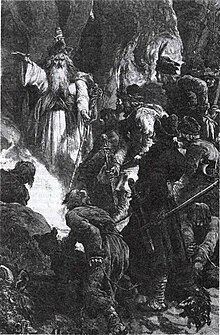
The Grand Duchy of Lithuania was a European state that existed from the 13th century to the late 18th century, when the territory was partitioned in 1795 among the Russian Empire, the Kingdom of Prussia, and the Habsburg Empire of Austria. The state was founded by Lithuanians, who were at the time a polytheistic nation born from several united Baltic tribes from Aukštaitija.

Traidenis was Grand Duke of Lithuania from 1269 or 1270 until 1282. He is the second most prominent grand duke of Lithuania in the 13th century after Mindaugas. His reign ended a seven-year unrest period after Mindaugas was assassinated in 1263 and firmly established the Grand Duchy as a pagan state for another hundred years.

Vaidotas was a son of Kęstutis, Grand Duke of Lithuania. In reliable historical sources he is mentioned only twice: as defender of Kaunas Castle in 1362 and as ruler of Navahrudak. Due to very limited information, his life is subject to wide-ranging theories by historians.

The Kiszka family was a noble family (szlachta) and one of the most powerful families (magnates) of the Grand Duchy of Lithuania in the Polish–Lithuanian Commonwealth. Originating from Mazovia, the family used the Dąbrowa Coat of Arms.

Rambynas is a hill on the right bank of the Neman River in Rambynas Regional Park, Pagėgiai Municipality, western Lithuania. The current hill, about 46 metres (151 ft) above sea level and about 40 metres (130 ft) above the Neman, is a remnant of the larger hill that was destroyed by erosion. The hill was known as sacred among locals and played a role in the ceremonies of pagan Lithuanians. It is featured in many local legends and is protected by the state as a mythological object. A large stone at the top of the hill, known as the altar stone, was destroyed by a miller in 1811. Rambynas became popular with Prussian Lithuanians at the end of the 19th century who organized various events, most notably celebrations of the Saint Jonas' Festivals or Rasos, on the hill. They rebuilt the altar in 1928. The hill is popular with Lithuanian neo-pagans and hosts the annual celebrations of the summer solstice on 23 June.

Kaributas was a son of Algirdas, Grand Duke of Lithuania, and reigned in Severian Novgorod until 1393.

The family of Gediminas is a group of family members of Gediminas, Grand Duke of Lithuania, who interacted in the 14th century. The family included the siblings, children, and grandchildren of the Grand Duke and played the pivotal role in the history of Lithuania for the period as the Lithuanian nobility had not yet acquired its influence. Gediminas was also the forefather of the Gediminid dynasty, which ruled the Grand Duchy of Lithuania from 1310s or 1280s to 1572.
The Lithuanian Chronicles are three redactions of chronicles compiled in the Grand Duchy of Lithuania. All redactions were written in the Ruthenian language and served the needs of Lithuanian patriotism. The first edition, compiled in the 1420s, glorified Vytautas the Great and supported his side in power struggles. The second redaction, prepared in the first half of the 16th century, started the myth of Lithuanian Roman origin: it gave a fanciful genealogy of Palemon, a noble from the Roman Empire who founded the Grand Duchy. This noble origin of Lithuanians was important in cultural rivalry with the Kingdom of Poland. The third redaction, known as the Bychowiec Chronicle, elaborated even further on the legend, but also provided some useful information about the second half of the 15th century. The three redactions, the first known historical accounts produced within the Grand Duchy, gave rise to the historiography of Lithuania. All medieval historians used these accounts, that survived in over 30 known manuscripts, as basis for their publications and some of the myths created in the chronicles persisted even to the beginning of the 20th century.
Fiodor of Kiev, was a prince of Kiev (Kyiv). Most likely he was the son of Butvydas, and a younger brother of Gediminas, Grand Duke of Lithuania, his pagan name is unknown and he was baptized as Orthodox Fiodor. Only a couple of short notes survive regarding Fiodor's life.

De moribus tartarorum, lituanorum et moscorum is a 16th-century Latin treatise by Michalo Lituanus. The work, which was originally dedicated to King of Poland and Grand Duke of Lithuania Sigismund II Augustus, survived only in ten fragments that were first published in 1615 by Johann Jacob Grasser in Basel, Switzerland.

Vygantas was Duke of Kernavė. He was one of the sons of Algirdas, Grand Duke of Lithuania (1345–1377), and his second wife Uliana Alexandrovna of Tver.

The history of Lithuania between 1219 and 1295 concerns the establishment and early history of the first Lithuanian state, the Grand Duchy of Lithuania. The beginning of the 13th century marks the end of the prehistory of Lithuania. From this point on the history of Lithuania is recorded in chronicles, treaties, and other written documents. In 1219, 21 Lithuanian dukes signed a peace treaty with Galicia–Volhynia. This event is widely accepted as the first proof that the Baltic tribes were uniting and consolidating. Despite continuous warfare with two Christian orders, the Livonian Order and the Teutonic Knights, the Grand Duchy of Lithuania was established and gained some control over the lands of Black Ruthenia, Polatsk, Minsk, and other territories east of modern-day Lithuania that had become weak and vulnerable after the collapse of Kievan Rus'.
Die Littauischen Wegeberichte is a compilation of 100 routes into the western Grand Duchy of Lithuania prepared by the Teutonic Knights in 1384–1402. The Knights waged the Lithuanian Crusade to convert pagan Lithuanians into Christianity since the 1280s. The crusade was characterized with frequent raids into the enemy territory to loot and pillage. Since Lithuania lacked a developed road network, local Lithuanian and Prussian scouts would describe and document the best and most effective routes for the military raids into Lithuania.
The Battle of the Vikhra River took place on 29 April 1386 on the Vikhra River, tributary of the Sozh River, near Mstislavl between the Grand Duchy of Lithuania and the Principality of Smolensk. The Lithuanians achieved a decisive victory and Smolensk was forced to accept being a vassal of Lithuania.
Česlovas Laurinavičius is a Lithuanian historian and politologist, In 2003, he was the recipient of the Knight's Cross of the Order for Merits to Lithuania. Since 2001, he has served as the head of the Department of the 20th Century History at the Lithuanian Institute of History.

Šventaragis' Valley is a valley at the confluence of Neris and Vilnia Rivers in Vilnius, Lithuania. According to a legend recorded in the Lithuanian Chronicles, it was where Lithuanian rulers were cremated before the Christianization of Lithuania in 1387. Maciej Stryjkowski further recorded that it was the location of a pagan temple dedicated to Perkūnas, the god of thunder. While the legends are generally dismissed as fiction by historians, they have been studied and analysed from the perspective of pre-Christian Lithuanian mythology by Vladimir Toporov, Gintaras Beresnevičius, Norbertas Vėlius, Vykintas Vaitkevičius, and others.
Jonas Radvanas was a Renaissance poet and protestant reformer from the Grand Duchy of Lithuania. Very little is known about his life and he is best remembered as the author of an epic poem Radivilias dedicated to the military achievements of Mikołaj "the Red" Radziwiłł. However, the poem goes beyond a simple panegyric and paints a broader patriotic image of the Grand Duchy. In total, he wrote 18 poems that were published in various publications by the Calvinists in the Grand Duchy. All of his works were written in Latin.

Radivilias is a Latin epic poem by Jonas Radvanas published in 1588. It is one of the major works of the 16th-century Lithuanian literature and one of the best examples of Renaissance literature in Lithuania. It uses hexameter and has 3,302 lines divided into four parts. It is dedicated to Mikołaj "the Red" Radziwiłł (1512–1584) and his major military victories in the Livonian War.

Danielius Alseika was a Lithuanian physician and activist. He was the father of the archaeologist Marija Gimbutas.
Ingė Lukšaitė is a Lithuanian cultural historian and university professor. She specializes in the history of the Reformation in Lithuania. She worked at the Lithuanian Institute of History for over four decades.














